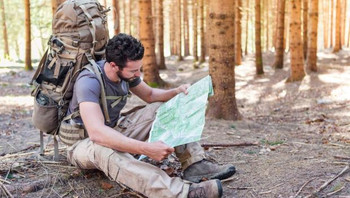Survival Skills Quick Guide
See items to help you to survive outdoors
You wont find crucial Outdoor survival skills in a fancy prep kit, or in a manual somewhere. You will need to have the ability to vs what you know in your mind. this quick course is just a few basic but important advice on staying warm, hydrated,so you can focus on navigating your fight or flight situation surviving outdoors.
Thaw cold feet
Swing your leg forcefully back and forth, like a pendulum. Inertia will force the blood to the tips of your toes.
Estimate your distance traveled
The average footstep is 30 inches, and a fit person can walk 3 mph over flat ground. Determining how far you’ve walked is critical for navigating through a whiteout or dense forest–or if you’re trying to pinpoint the exact location of a trail junction or landmark.
Find north using a clock face
Hold an analog watch flat, with the hour hand aimed at the sun. South will be halfway between the hour hand and 12. North is 180 degrees in the opposite direction. Adjust for daylight-saving time by using 1:00 instead of noon. If you wear a digital watch, draw a clock face on the ground. This technique works for North America below Alaska, but it should only be used for emergency navigation. Always bring a compass and a map of your route.
Orient yourself using the moon
If the crescent moon rises before the sun goes down (a first-quarter moon), its illuminated side will face west. If it rises after midnight (a last-quarter moon), the bright side will face east. (using the north star is easier and more reliable, but try this lunar method if stars are obscured.)
Find a natural bandage
Gather dried sphagnum moss–soft, bushy, green clumps–from bogs or swamps. WWI soldiers used it to stanch their wounds because it’s antibacterial and as absorbent as cotton. Press it against a bleeding wound, or bind it on top of a sterile pad after the blood clots.
Escape biting insects
Seek out windy spots, or apply mud to exposed skin. Rub flakes of birch bark on your skin and clothing–the oil repels bugs. Mosquitoes are attracted to wet and dark-colored clothing, as well as perspiration. They are most active at dawn and dusk, when the air is calm.
Identify a coral snake
Remember: “red on yellow, kill a fellow. Red on black, friend of jack.” poisonous coral snakes, with adjacent red and yellow bands and a black head, live predominantly in the southeast and southwest. Similar-looking scarlet king snakes, with their adjacent red and black bands, are harmless constrictors that range from Florida to New Jersey.
Re-warm frostbitten skin
Place the white, waxy frozen skin in lukewarm water or apply hot wet cloths until It becomes pink as blood flow returns. Never apply dry heat; frostbitten skin easily burns. To avoid damaging tissue, don’t rub or massage skin. Taking ibuprofen manages pain and can reduce the chance of blood clots.
Self-arrest without an ice axe
Roll onto your stomach, facing uphill. Push up with your elbows to shift more weight to your legs and feet. Your body will create a natural wedge as your boots dig into the ground.
Fix a broken shoelace
If your lace is too short, skip the eyelets near the toes. Just lace up the ankle and cuff of the boot to achieve a tight fit. If you lose an entire shoelace, cut the other one in half.
Identify and treat heat exhaustion
A victim will be sweating heavily, with cool, wet, flushed skin. Dizziness, vomiting, headache, and a rapid pulse are also possible. Have the person lie down in a cool, shaded place. Elevate his or her feet, fan them, spritz them with water, and provide cool drinks and salty snacks.
Scree slopes often provide obstruction-free access to higher elevations, but they can also be tiring to climb. Kick a step with your toe into the loose stones and shift your weight onto your forward foot. Repeat by bringing your back foot up.
Descend a scree slope
Walk using short, shuffling steps with your feet pointed downhill while digging in your heels. In open areas without hazards such as cliffs or boulders, try taking longer, plunging steps as if you were descending powder snow. An ice axe or trekking poles are helpful. Group members should move close together or side by side to avoid dislodging rocks that could injure someone moving below.
Make water from snow
Melt snow over a stove by adding a little water to the mixture. Choose the wettest snow you can find. Icicles also work. No fire? Fill a bottle one-third full with snow or ice and one-third with water. Shake it well, and place it between the layers of clothing. Do not put the container next to your skin; it will rob your body heat through conduction.
Splint a broken arm
Wrap a deflated sleeping pad tightly around the broken limb; secure the pad with pack straps, and then inflate it. No pad? Place straight sticks as splints on either side of the arm and secure them with straps or cloth strips. Don’t tie knots directly against the skin. Immobilize the limb by securing it across the victim’s body. For wrist fractures, rest the forearm on a flat piece of bark and suspend it with straps from the torso and neck.
Escape an avalanche
If you’re caught in a slide, move your arms and legs in swimming motions to remain near the surface and upright. Grab any objects that you can push off against to maintain your balance. As the slide slows down, cup your palms in front of your face to create a breathing space before the snow hardens around you.
Estimate daylight
Approximately four fingers of your outstretched hand between the sun and horizon indicate 1 hour of sunlight remaining. Each additional finger represents 15 more minutes of daylight.
Know your water needs
In a temperate climate, a person loses an average of 1.5 liters of water every 24 hours through sweating, breathing, and urination. Physical exertion and high heat can increase that deficit to as much as 1 liter per hour. The minimum level of water replacement depends on the air temperature and your activity level. If you’re resting at 80°f, you will need to consume a minimum of 1 liter every 24 hours to stay alive. If your water supplies are limited, you need to stay in the shade and avoid exertion.
Collect dew
Wrap absorbent clothing around your lower legs, and walk through tall dew-covered grasses. Then wring the moisture from the clothing into a container or your mouth
Make rope
Peel away the outer bark of dead tree trunks to get at the long strands of dried inner bark. Or strip and roll together the fibrous stalks of hemp plants such as dogbane, which has red stems and smooth leaves and grows along riverbanks and marshes.
Signal distress
Build a large X (as large as you can make it) on the ground with rocks or gear; signal SOS (three dots, three dashes, three more dots) with a whistle or a mirror; or wave your arms in a circle if you are spotted. For signal fires, create black smoke by burning petroleum products.

